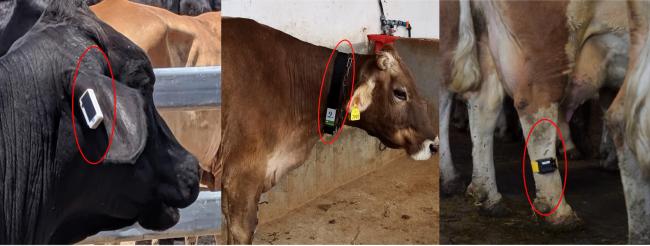[Significance] The beef cattle industry plays a pivotal role in the development of China's agricultural economy and the enhancement of people's dietary structure. However, there exists a substantial disparity in feeding management practices and economic efficiency of beef cattle industry compared to developed countries. While the beef cattle industry in China is progressing towards intensive, modern, and large-scale development, it encounters challenges such as labor shortage and rising labor costs that seriously affect its healthy development. The determination of animal physiological indicators plays an important role in monitoring animal welfare and health status. Therefore, leveraging data collected from various sensors as well as technologies like machine learning, data mining, and modeling analysis enables automatic acquisition of meaningful information on beef cattle physiological indicators for intelligent management of beef cattle. In this paper, the intelligent monitoring technology of physiological indicators in beef cattle breeding process and its application value are systematically summarized, and the existing challenges and future prospects of intelligent beef cattle breeding process in China are prospected. [Progress] The methods of obtaining information on beef cattle physiological indicators include contact sensors worn on the body and non-contact sensors based on various image acquisitions. Monitoring the exercise behavior of beef cattle plays a crucial role in disease prevention, reproduction monitoring, and status assessment. The three-axis accelerometer sensor, which tracks the amount of time that beef cattle spend on lying, walking, and standing, is a widely used technique for tracking the movement behavior of beef cattle. Through machine vision analysis, individual recognition of beef cattle and identification of standing, lying down, and straddling movements can also be achieved, with the characteristics of non-contact, stress-free, low cost, and generating high data volume. Body temperature in beef cattle is associated with estrus, calving, and overall health. Sensors for monitoring body temperature include rumen temperature sensors and rectal temperature sensors, but there are issues with their inconvenience. Infrared temperature measurement technology can be utilized to detect beef cattle with abnormal temperatures by monitoring eye and ear root temperatures, although the accuracy of the results may be influenced by environmental temperature and monitoring distance, necessitating calibration. Heart rate and respiratory rate in beef cattle are linked to animal diseases, stress, and pest attacks. Monitoring heart rate can be accomplished through photoelectric volume pulse wave measurement and monitoring changes in arterial blood flow using infrared emitters and receivers. Respiratory rate monitoring can be achieved by identifying different nostril temperatures during inhalation and exhalation using thermal infrared imaging technology. The ruminating behavior of beef cattle is associated with health and feed nutrition. Currently, the primary tools used to detect rumination behavior are pressure sensors and three-axis accelerometer sensors positioned at various head positions. Rumen acidosis is a major disease in the rapid fattening process of beef cattle, however, due to limitations in battery life and electrode usage, real-time pH monitoring sensors placed in the rumen are still not widely utilized. Changes in animal physiology, growth, and health can result in alterations in specific components within body fluids. Therefore, monitoring body fluids or surrounding gases through biosensors can be employed to monitor the physiological status of beef cattle. By processing and analyzing the physiological information of beef cattle, indicators such as estrus, calving, feeding, drinking, health conditions, and stress levels can be monitored. This will contribute to the intelligent development of the beef cattle industry and enhance management efficiency. While there has been some progress made in developing technology for monitoring physiological indicators of beef cattle, there are still some challenges that need to be addressed. Contact sensors consume more energy which affects their lifespan. Various sensors are susceptible to environmental interference which affects measurement accuracy. Additionally, due to a wide variety of beef cattle breeds, it is difficult to establish a model database for monitoring physiological indicators under different feeding conditions, breeding stages, and breeds. Furthermore, the installation cost of various intelligent monitoring devices is relatively high, which also limits its utilization coverage. [Conclusion and Prospects] The application of intelligent monitoring technology for beef cattle physiological indicators is highly significance in enhancing the management level of beef cattle feeding. Intelligent monitoring systems and devices are utilized to acquire physiological behavior data, which are then analyzed using corresponding data models or classified through deep learning techniques to promptly monitor subtle changes in physiological indicators. This enables timely detection of sick, estrus, and calving cattle, facilitating prompt measures by production managers, reducing personnel workload, and improving efficiency. The future development of physiological indicators monitoring technologies in beef cattle primarily focuses on the following three aspects: (1) Enhancing the lifespan of contact sensors by reducing energy consumption, decreasing data transmission frequency, and improving battery life. (2) Integrating and analyzing various monitoring data from multiple perspectives to enhance the accuracy and utility value. (3) Strengthening research on non-contact, high-precision and automated analysis technologies to promote the precise and intelligent development within the beef cattle industry.















